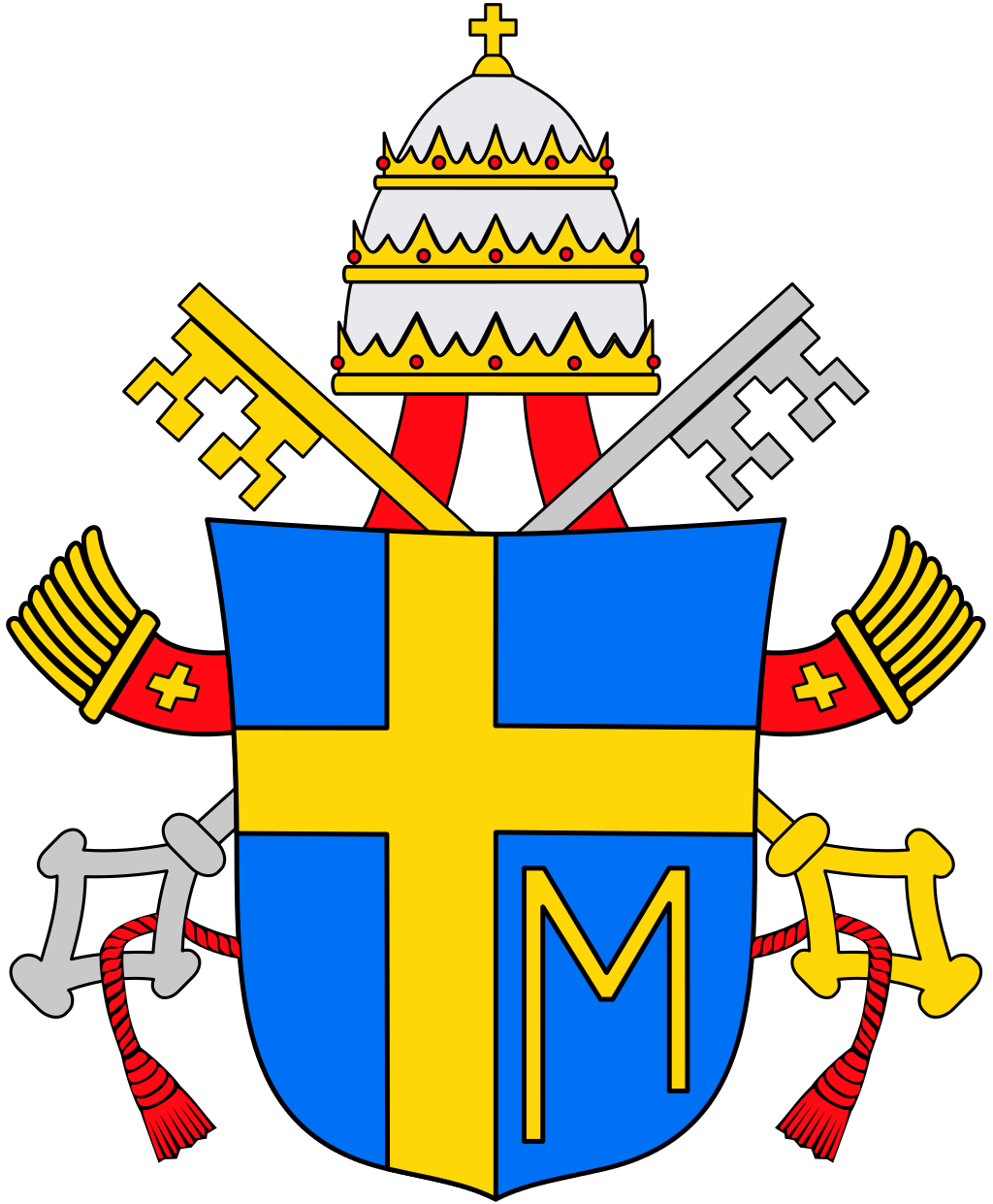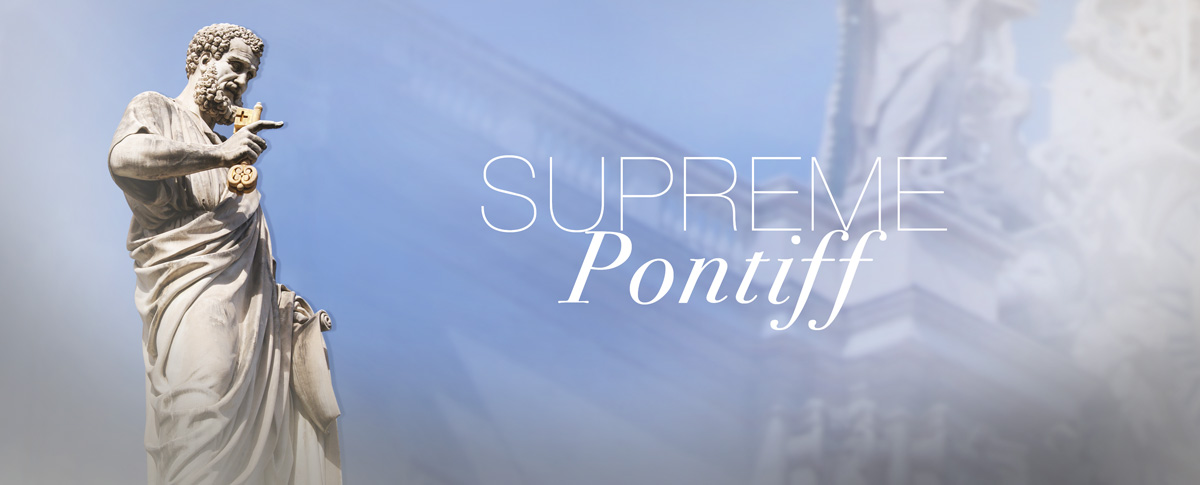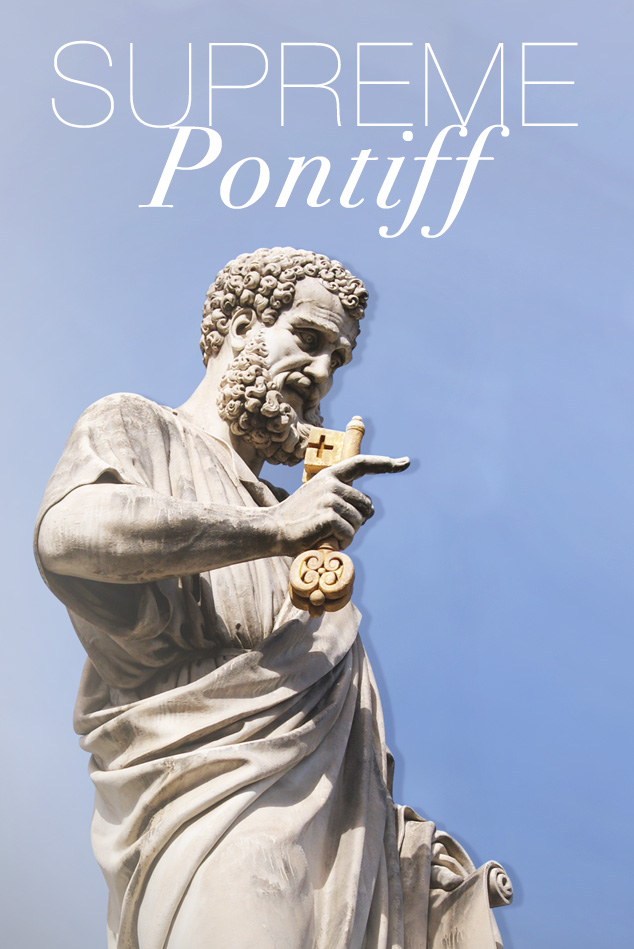Bishop of Rome, Vicar of Jesus Christ, Successor of St. Peter, Prince of the Apostles, Supreme Pontiff of the Universal Church, Primate of Italy, Archbishop and Metropolitan of the Roman Province, Sovereign of Vatican City State, Servant of the Servants of God
First and foremost the man who is Pope is the Bishop of Rome. From this office derives all the other offices and titles he holds. As the Roman bishop he is the Vicar of Christ because he succeeds the Prince of the Apostles in the Roman See. He is likewise the head of his brother bishops in the Roman Ecclesiastical Province, that is, he is Archbishop and Metropolitan. Furthermore, he is the First Bishop or Primate of Italy. Finally, in worldly matters, he is the Sovereign of the Vatican City State, a temporal rule which helps preserve the independence of the papacy.
It should be noted that the use of the title “Patriarch of the West,” dating from the era of the East -West division of the late Roman Empire, has been dropped by Pope Benedict XVI. The Bishop of Rome remains, nonetheless, one of the five ancient Patriarchs of the Church (Rome, Constantinople, Alexandria, Antioch and Jerusalem), as well as, Bishop of one of three Petrine Sees (Rome, Antioch, and Alexandria, the latter founded by Peter through his disciple Mark).
The Bishop of Rome is also known as the Servant of the Servants of God, since in imitation of Christ he is called to serve the People of God. As spiritual father to all Christians he is likewise Pope or papa, and Holy Father and Holiness, not because he is holy but because the things of Christ which he administers are holy. All of these offices belong to the man elected Bishop of Rome.
The key is the symbol of the authority of the vizier (the major domo/ prime minister/ treasurer/ vicar) of a royal household. He literally carried the keys attached to his belt, with which to open the storehouses and other treasuries on behalf of the king. In Scripture only the Messiah and the Apostle Peter are spoken of as having this authority.
The Messiah is the Vizier of the great King, the Eternal Father, bringing to earth the treasure of Redemption from the Storehouse of the Father’s mercy. Peter is the Messiah’s Vizier, the Vicar of Christ, who through his successors in every age is head of the Church on earth which distributes those treasures in the name of the Lord. (Isaiah 22:22, Rev 3:7, Mt 16:19) to the other apostles is given the power to bind and to loose, but not the supreme power of the keys (Mt 18:18).
I will place the key of the House of David on his shoulder; when he opens, no one shall shut, when he shuts, no one shall open.
Amen, I say to you, whatever you bind on earth shall be bound in heaven, and whatever you loose on earth shall be loosed in heaven.
“To the angel of the church in Philadelphia, write this: “ ‘The holy one, the true, who holds the key of David, who opens and no one shall close, who closes and no one shall open, says this:
I will give you the keys to the kingdom of heaven. Whatever you bind on earth shall be bound in heaven; and whatever you loose on earth shall be loosed in heaven.”
Each Pope selects his own coat of arms, using the devices of heraldry. Typically they include the crossed silver and gold keys, representing the Pope’s spiritual and temporal authority, as well as the papal tiara. In his coat of arms, however, Pope Benedict substituted the miter for the tiara.
To these general symbols of the papacy the Pope will add devices and/or text which are individual to himself. Pope John Paul II, for example, had the blue field, Mary’s color, with the Cross of Our Lord and the M of Mary under the Cross, showing the importance of Jesus and Mary in his personal spirituality.



The Papal Tiara is a crown symbolizing the threefold authority of the Supreme Pontiff: Universal Pastor (top), Universal Ecclesiastical Jurisdiction (middle) and Temporal Power (bottom) . Of this last, only the Vatican City State remains from the papal territories, which in past ages secured the autonomy of the Vicar of Christ from the princes of this world.
The triple tiara can also be understood to have a spiritual interpretation, the three-fold office of Christ, Who is Priest, Prophet and King. The Lord communicated these offices to the Apostles, and in a particular way to Peter, so that they could sanctify, teach and govern in His name and by His authority (Mt 16:13-18, Mt 18:18, Mt 28:18-20, Lk 22:31-32, John 21:15-17).
Pope Paul VI was the last pontiff to wear the papal tiara. At the end of the Second Vatican Council, Pope Paul VI descended the steps of the papal throne in St. Peter’s Basilica and laid the tiara on the altar in a dramatic gesture of humility and as a sign of the renunciation of human glory and power in keeping with the renewed spirit of the Second Vatican Council. This last tiara was then given to benefit the poor, but remains as a symbol in the papal crest.
Matthew 18:18: Amen, I say to you, whatever you bind on earth shall be bound in heaven, and whatever you loose on earth shall be loosed in heaven.
Matthew 16:13-18 : When Jesus went into the region of Caesarea Philippi he asked his disciples, “Who do people say that the Son of Man is?” [14] They replied, “Some say John the Baptist, others Elijah, still others Jeremiah or one of the prophets.” [15] He said to them, “But who do you say that I am?” [16] Simon Peter said in reply, “You are the Messiah, the Son of the living God.” [17] Jesus said to him in reply, “Blessed are you, Simon son of Jonah. For flesh and blood has not revealed this to you, but my heavenly Father. [18] And so I say to you, you are Peter, and upon this rock I will build my church, and the gates of the netherworld shall not prevail against it.
Matthew 28:18-20 : Then Jesus approached and said to them, “All power in heaven and on earth has been given to me. [19] Go, therefore, and make disciples of all nations, baptizing them in the name of the Father, and of the Son, and of the holy Spirit, [20] teaching them to observe all that I have commanded you. And behold, I am with you always, until the end of the age.”
Luke 22:31-32 : “Simon, Simon, behold Satan has demanded to sift all of you like wheat, [32] but I have prayed that your own faith may not fail; and once you have turned back, you must strengthen your brothers.”
John 21:15-17 : When they had finished breakfast, Jesus said to Simon Peter, “Simon, son of John, do you love me more than these?” He said to him, “Yes, Lord, you know that I love you.” He said to him, “Feed my lambs.” [16] He then said to him a second time, “Simon, son of John, do you love me?” He said to him, “Yes, Lord, you know that I love you.” He said to him, “Tend my sheep.” [17] He said to him the third time, “Simon, son of John, do you love me?” Peter was distressed that he had said to him a third time, “Do you love me?” and he said to him, “Lord, you know everything; you know that I love you.” (Jesus) said to him, “Feed my sheep.”
Pro Pontifice
V. Oremus, pro Pontifice nostro N. (e.g. Ioanne Paulo Secundo)
R. Dominus conservet eum, et vivificet eum, et beatum faciat eum in terra, et beatum faciat eum in terra, et non tradat eum in animam inimicorum ejus.
V. Let us pray for our Pope N. (e.g. John Paul II)
R. The Lord preserve him and keep him alive, that he may be blessed upon earth ; and deliver him not into the will of his enemies.
Tu Es Petrus
Tu es Petrus, et super hanc petram aedificabo Ecclesiam meam.
Et portae inferi non praevalebunt adversus eam:
et tibi dabo claves regni caelorum.
Quodcum que ligaveris super terram, erit ligatum et caelis.
Et quodcumque solveris super terram, erit solutum et in caelis.
Thou art Rock, and upon this rock I will build my Church And the gates of hell will not prevail against it. And I will give to you the keys of the Kingdom of heaven Whatever you bind on earth will be bound in heaven. And whatever you loose on earth will be loosed in heaven.
(Gregorian chant Tract for the Feast of the Chair of St. Peter, 18 January)
Long Live The Pope
Long live the Pope! His praises sound Again and yet again: His rule is over space and time: His throne the heart of men: All hail! The Shepherd Pope of Rome, The theme of loving song: Let all the earth his glory sing And heav’n the strain prolong.
Beleaguered by By the foes of earth, Beset by hosts of hell, He guards the loyal flock of Christ, A watchful sentinel: And yet, amid the din and strife, The clash of mace and sword, He bears alone the Shepherd Staff, The champion of the Lord.
Then raise the chant, With heart and voice, In Church & school & home: “Long live the Shepherd of the Flock! Long live the Pope of Rome!” Almighty Father bless his work, Protect him in his ways, Receive his prayer, fulfill his hopes, And grant him length of days!
The Pontifical March
Hail, O Rome Eternal abode of memories; A thousand psalms and a thousand altars Sing your praises
CHORUS: City of the Apostles, Mother and guide of the elect, Light of the nations And hope of the world!
Hail, O Rome Your light will never fade; The splendor of your beauty Disperses hatred and shame.
Repeat Chorus
The Pontifical Hymn
Rome immortal, city of martyrs and saints, Immortal Rome, accept our praises. Glory in the heavens to God our Lord And peace to the men who love Christ!
To you we come, angelic Pastor, In you we see the gentle redeemer. You are the holy heir of our Faith, You are the comfort and the refuge of those who believe and fight
Force and terror will not prevail, But truth and love will reign
Adopted in 1950 Words by Antonio Allegra (1905-1969)
Archbishop Pasquale Macchi, (d. 2006) former personal secretary of Pope Paul VI, kept the wax cast of a ring made for Paul VI by the artist, by Henry Manfrini. The ring depicts Peter holding keys. (Manfrini had made several medals and other artistic objectsfor Paul VI). The ring was never cast into metal, and Paul VI had never worn it because he always wore the ring that was commissioned at the time of the Second Vatican Council. Archbishop Macchi left the cast, along with other objects, to Monsignor Ettore Malnati, who worked closely with him for many years. Monsignor Malnati made a ring of gold-plated silver from the wax cast. This was offered to Pope Francis, along with several other possible rings, by the Papal Master of Ceremonies, through the auspices of Cardinal Re. It was this ring that Pope Francis [chose] to be the ring of the Fisherman, presented to him at the Mass of Inauguration of his Petrine Ministry.
[Provided by the Vatican Press Office]

